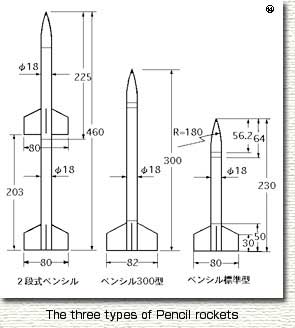 |
 |
|
|
I didn't know anything about rockets at that time. I had understood the structure of jet engines thanks to the diploma design, but when Professor Itokawa came into my office and talked about several things associated with the rocket, I could barely understand what he was talking about. I thought it was a pendant because some lady was calling a thing around her neck a "rocket" (locket). I realized that Professor Itokawa was talking about a missile two days after his visit. Till then, I was wondering why I had to conduct research on accessories for ladies. I didn't know what kind of materials rockets used or anything about their structure. I didn't even know how they flew. So, I had to study about them from the beginning. (Kakimi)
Inside the Pencil rocket, was "software" designed by professors from the University of Tokyo. For the rocket's nose, Professor Hideo Itokawa's idea was to draw a curve, called a tangent, from the middle line with a compass. There are various types of tail wing shapes, but for the Pencil rocket, Professor Akio Tamaki's idea of a clipped delta wing was applied.
We had to measure the internal pressure and thrust of the rocket, but as we couldn't tell when it would explode, we made a test stand at the Ogikubo factory. However, we did not know what we had to do at first, so we dug a hole about the size of a man and made an underground combustion room for the experiment using concrete. (Toda)
Around that time, we found out there were larger propellants than the ones initially used in the Pencil rocket, which were 65 mm wide and 110 mm long. These propellants were at Nippon Oil & Fats (NOF) in Taketoyo. Thus, at the same time, we started to develop the Baby rocket and tests on it began at the test stand at the Ogikubo factory. At the beginning, its thrust was unexpectedly strong and the vibrations caused the lathe in the next factory to move. We were then told not to do such tests at Ogikubo as the lathe would become useless and were forced to stop our tests at the factory.
|
 |
 |
 |
(8/15) |
 |
|
 |